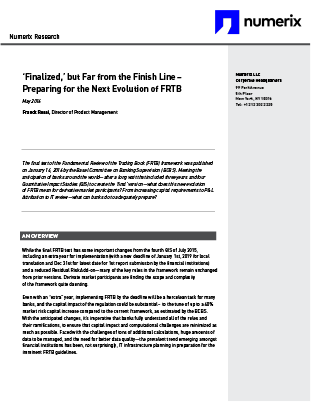
‘Finalized,’ but Far from the Finish Line – Preparing for the Next Evolution of FRTB
While the final FRTB text has some important changes from the fourth QIS of July 2015, including an extra year for implementation (with a new deadline of January 1st, 2019 for local translation and Dec 31st for latest date for 1st report submission by the financial institutions) and a reduced Residual Risk Add-on—many of the key rules in the framework remain unchanged from prior versions. Derivate market participants are finding the scope and complexity of the framework quite daunting.
What can be done to adequately prepare for FRTB implementation? Clearly, this is a highly complex question without simple answers. For simplification purposes, this paper breaks down the key implications, requirements and methodologies related to the FRTB ‘final’ text and implementation. First, the paper starts by addressing the increasing capital risk charges of considerable concern to today’s derivative market participants—as they continue to rethink derivative business strategy and impact on overall profitability. Next, our study explores the computational implications of FRTB and provides a comparison of the current framework vs. the FRTB framework for the Standardized Approach and Internal Model Approach.
As the paper unfolds, it provides a comprehensive breakdown of the Standardized Approach and Internal Model Approach, including detailed methodologies and prescribed formulas—highlighting overall computational and data challenges and the need for organizations to review, and potentially revamp, IT infrastructure in preparation.
HIGHLIGHTS OF THE PAPER INCLUDE:
- FRTB Market Risk Capital Requirements under Standardized Approach and Internal Model Approach
- Detailed Breakdowns of Newly Prescribed FRTB Calculation Requirements
- Methodologies for the Current Framework vs. FRTB Framework—for both the Standardized Approach and the Internal Model Approach
- Overview of Residual Risk Add-On as Revised in 'Final' FRTB Text
- P&L Attribution and Its Challenges
Complete the form to the right to download this complimentary whitepaper, “Finalized,’ but Far from the Finish Line – Preparing for the Next Evolution of FRTB.”
Authors

Franck Rossi
Franck Rossi is a Vice President of Product Management at Numerix, responsible for product strategy and thought leadership related to banking and derivatives regulations. He also works with clients to understand and document their requirements so Numerix can develop the required functionality in its software. Prior to joining Numerix, Mr. Rossi worked at Thomson Reuters in Product Management in Regulations, Analytics and Structured Products, and at HSBC in Interest Rate Structured Products. He holds an MSc in Finance and Mathematics from Paris-Dauphine University.


